You’re facing a unique challenge when selecting plants for Idaho’s dramatic landscape. The state’s elevation changes from 710 feet in Lewiston to 12,662 feet at Borah Peak, creating distinct microclimates that demand careful plant selection. Your mountain garden won’t thrive with the same species as your prairie plot, and choosing wrong means watching your investment wither. The secret lies in understanding which natives handle Idaho’s temperature swings, unpredictable precipitation, and varying soil conditions.
Contents
- 1 Idaho’s Diverse Elevation Challenges
- 2 Wildflowers for Idaho Gardens
- 3 Native Conifers and Deciduous Trees
- 4 Hardy Shrubs for Rocky Terrain
- 5 Selecting the Right Native Plants for Your Garden
- 6 Frequently Asked Questions
- 6.1 How Do I Legally Harvest Native Plant Seeds From Public Lands?
- 6.2 What Native Plants Are Deer Resistant in Idaho?
- 6.3 How Much Do Native Idaho Plants Typically Cost Compared to Non-Natives?
- 6.4 When Is the Best Time to Plant Native Species in Idaho?
- 6.5 Do Idaho Native Plants Require Special Soil Amendments or Fertilizers?
Idaho’s Diverse Elevation Challenges
When you’re selecting native plants for Idaho, elevation becomes your biggest challenge because the state’s dramatic height differences create wildly different growing conditions. At Lewiston’s 710 feet, you’ll deal with warmer temperatures and less moisture. But climb to Borah Peak’s 12,662 feet, and you’re facing harsh alpine conditions with heavy snowfall.
The elevation impact on plant survival is massive. Central Idaho’s mountains, ranging from 1,600 to 8,200 feet, demonstrate this perfectly—precipitation increases from 25 to 80 inches annually as you gain altitude. Approximately 60% falls as snow in these higher elevations, creating unique moisture conditions that affect which native species will thrive. Your climate adaptation strategy must account for these extreme variations within relatively short distances.
Wildflowers for Idaho Gardens
Idaho’s diverse climate supports an impressive array of native wildflowers, from rare endemic species and drought-tolerant prairie varieties to moisture-loving blooms and low-maintenance perennial options for gardens. Some wildflowers create such spectacular displays that common camas blooms are often mistaken for lakes when viewed from a distance due to their profuse flowering.
Indian Paintbrush (Castilleja)
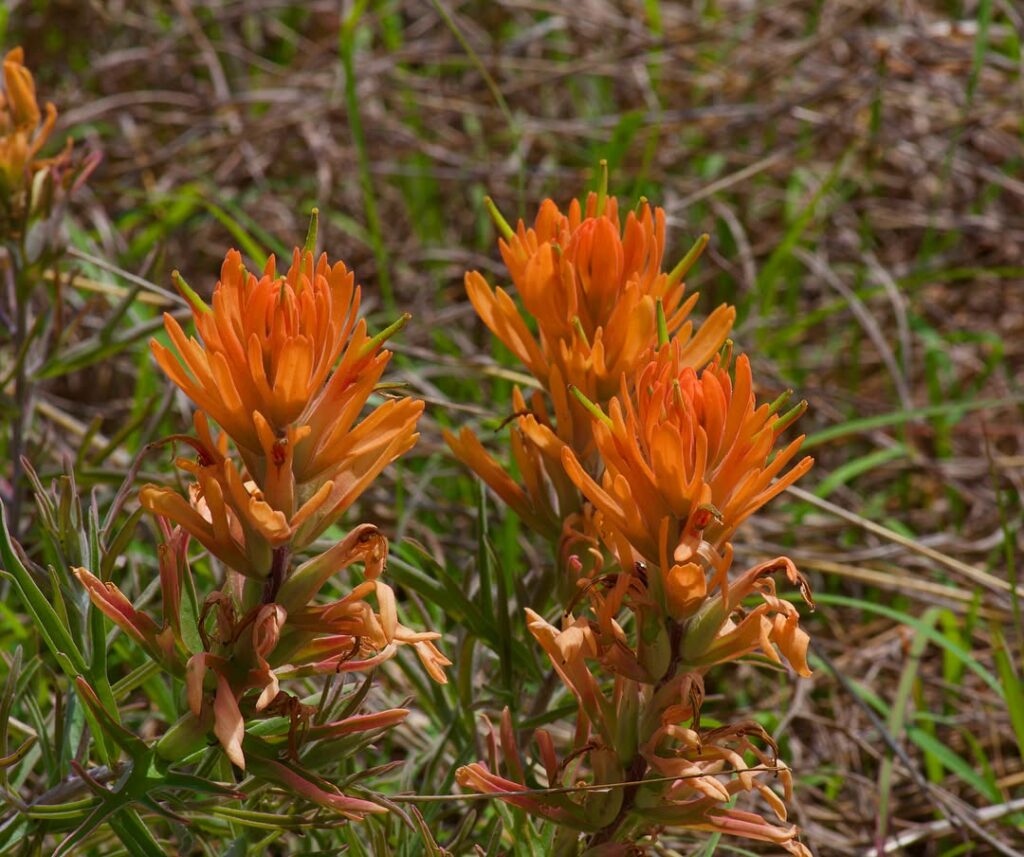
Indian paintbrush (Castilleja) creates stunning displays with its vibrant, colorful bracts that are often mistaken for flowers. These hardy wildflowers feature bright orange to red or yellow-orange flowering spikes rising 6-8 inches tall above green foliage. The true flowers are small and greenish-yellow, hidden within the showy bracts.
As hemi-parasitic plants, Indian paintbrush species can produce their own nutrients while also forming root attachments to nearby host plants for additional sustenance. This unique characteristic makes them excellent companion plants that thrive alongside balsam ragwort, little bluestem, wood lily, and hairy beardtongue, creating diverse seasonal color displays from spring through summer. Seeds of some species exhibit strong dormancy and may require three months or more of cool, moist conditions to germinate successfully.
- Hardiness: Cold-hardy perennial suitable for Idaho’s mountain and prairie environments
- Light: Full sun; requires open areas and does not perform well in shade
- Water: Moderate moisture requirements; tolerates drought once established
- Soil: Well-draining soils; thrives in thin, moist soils over limestone bedrock
- Fertilizer: Low to no fertilizer needs due to hemi-parasitic nature
- Pest/Disease Resistance: Generally resistant to common pests and diseases
- Growth Rate: Slow to moderate establishment; reaches 6-8 inches at maturity
Lupine

Lupine species are stunning native wildflowers that bring vibrant displays of blue and purple blooms to Idaho gardens. These members of the pea family feature distinctive palmate leaves with silvery hairs and tall flower spikes that create dramatic vertical interest from May through July. Beyond their ornamental value, lupines serve critical ecological functions by fixing nitrogen in the soil and providing essential nectar sources for native pollinators.
With multiple varieties thriving across Idaho’s diverse landscapes—from prairie foothills to subalpine meadows—lupines are exceptionally well-adapted to local conditions. Their drought tolerance and ability to flourish in poor soils make them invaluable for waterwise landscaping and habitat restoration projects, while their showy blooms and wildlife benefits make them perfect additions to native plant gardens. The palmately compound leaves are divided into 7-11 leaflets, creating an attractive foliage display even when plants are not in bloom.
- Hardiness: Hardy in USDA zones 3-8, well-adapted to Idaho’s temperature extremes
- Light: Full sun to partial sun; performs best in open, sunny locations
- Water: Low to moderate water needs; drought tolerant once established
- Soil: Well-drained, sandy or rocky soils; tolerates poor fertility and alkaline conditions
- Fertilizer: None required; actually benefits from low-nutrient soils due to nitrogen-fixing ability
- Pest/Disease Resistance: Generally pest and disease resistant; may experience aphid issues occasionally
- Growth Rate: Moderate growth rate; slow to establish but long-lived once mature
Blanketflower (Gaillardia Aristata)
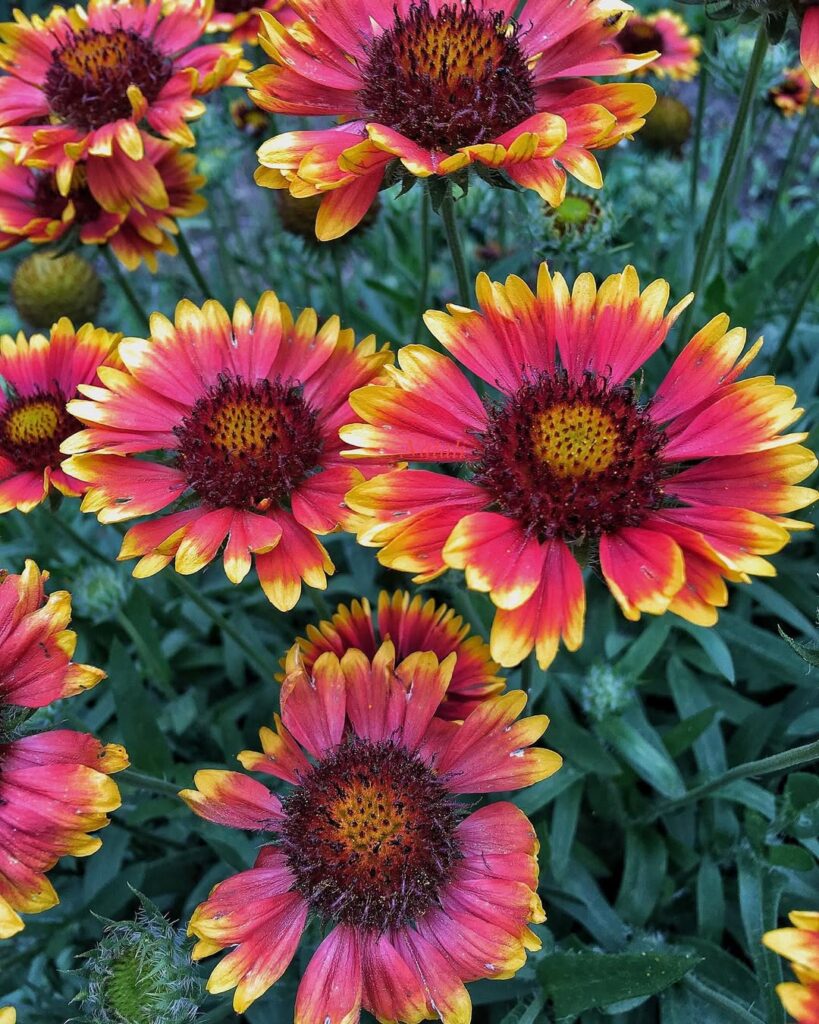
Blanketflower (Gaillardia aristata) is a hardy native perennial that brings vibrant color to Idaho gardens with its large, daisy-like blooms in shades of yellow, orange, and red. Growing 1-2 feet tall from a deep taproot, this drought-tolerant wildflower thrives in the state’s challenging mountain and prairie climates.
This low-maintenance beauty provides exceptional value for both gardeners and wildlife, attracting pollinators throughout its long blooming season while requiring minimal care once established. Its adaptability to rocky soils and extreme cold makes it ideal for naturalized areas, wildflower meadows, and water-wise landscapes. The plant readily self-seeds in favorable conditions, naturally expanding wildflower displays over time.
- Hardiness: USDA Zones 2-9, extremely cold-hardy
- Light: Full sun required for optimal growth and flowering
- Water: Low water needs once established; drought-tolerant due to deep taproot
- Soil: Well-drained soils; tolerates rocky, sandy, and poor substrates
- Fertilizer: No fertilizer needed; thrives in native soil conditions
- Pest/Disease Resistance: Excellent resistance; very few pest or disease issues
- Growth Rate: Moderate; reaches mature size in 1-2 seasons, long-lived perennial
Penstemon (Beardtongue)
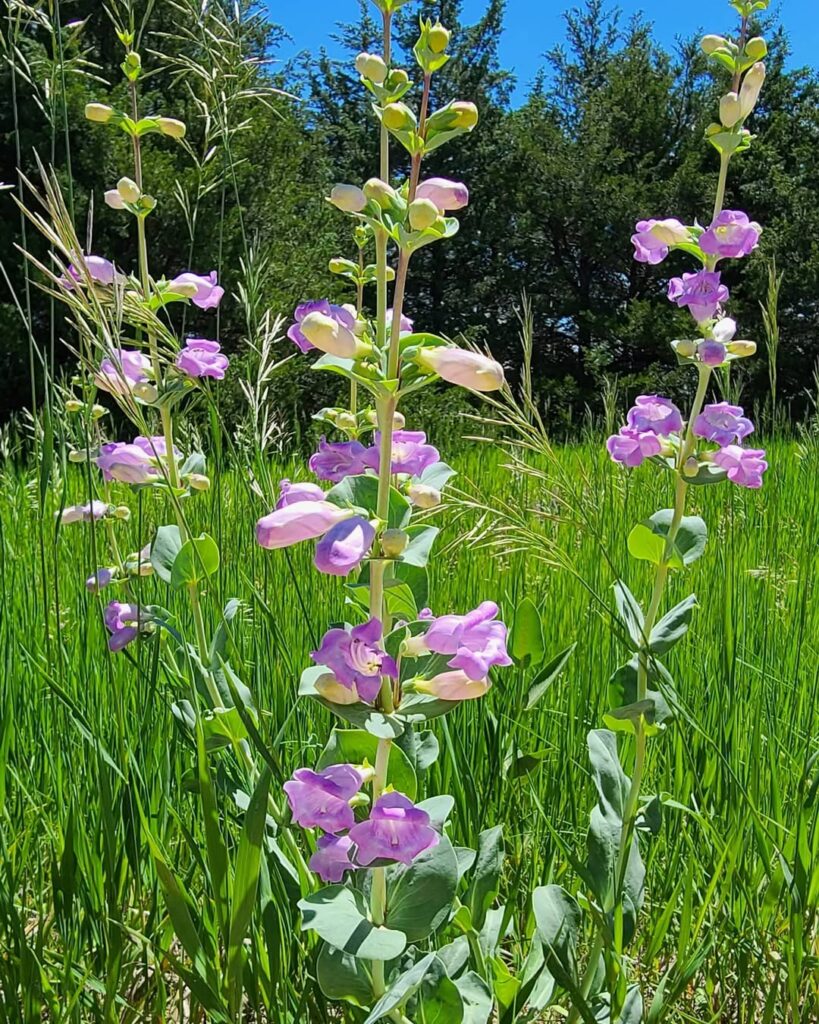
Penstemon, commonly known as beardtongue, represents North America’s largest endemic flowering plant genus with over 270 species. These perennial wildflowers produce distinctive tubular blooms in shades of blue, violet, and purple from late spring through mid-summer. Idaho hosts several notable species including the showy Penstemon speciosus with its bright purple flowers, the taller Rocky Mountain penstemon (P. strictus), and the endemic Idaho beardtongue (P. idahoensis).
These adaptable plants thrive across Idaho’s diverse landscapes, from sagebrush steppe to ponderosa pine forests and sub-alpine regions. Their tubular flowers serve as magnets for native pollinators, particularly bees and hummingbirds, making them essential components of sustainable wildflower gardens. Growth habits range from compact 8-inch ground covers to upright 3-foot specimens, providing versatility for various garden applications. The American Penstemon Society provides comprehensive resources and maintains databases for enthusiasts looking to learn more about these remarkable native plants.
- Hardiness: Zones 3-8, well-adapted to Idaho’s mountain and prairie climates
- Light: Full sun to partial shade
- Water: Low to moderate; drought-tolerant once established, prefers less than 12″ annual precipitation
- Soil: Well-draining, rocky or sandy soils; tolerates poor, alkaline conditions
- Fertilizer: Minimal requirements; avoid over-fertilizing which can reduce flowering
- Pest/Disease Resistance: Generally resistant with good drainage; susceptible to root rot in wet conditions
- Growth Rate: Moderate; can persist 7+ years and spread via stolons in some species
Rocky Mountain Iris (Iris Missouriensis)
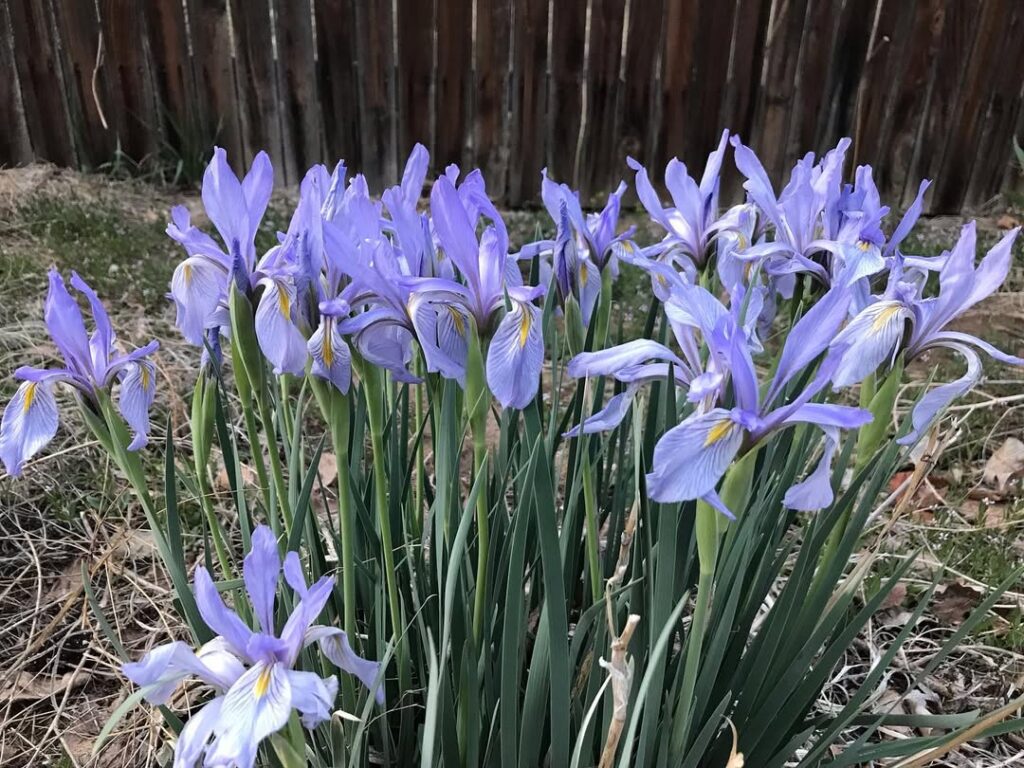
Rocky Mountain Iris (Iris missouriensis) is a striking native perennial that brings elegant beauty to Idaho gardens with its delicate pale blue, violet, purple, or white flowers adorned with prominent purple veines. This hardy wildflower grows up to 2 feet tall from dense clumps, producing sword-shaped foliage and one to four blooms per stem from May through September.
Naturally found in marshes, wet meadows, and stream margins throughout the western United States, this versatile iris thrives at elevations up to 10,500 feet. Its deer-resistant nature and ability to form large colonies make it excellent for wildflower gardens, water features, and restoration projects while providing habitat for native moths. The blooms are particularly valuable for attracting hummingbirds to the garden ecosystem.
- Hardiness: USDA zones 3-9, cold tolerant to -15°F
- Light: Full sun to partial shade
- Water: High moisture requirements, especially during growth and bloom periods
- Soil: Sandy or well-drained soils, tolerates various soil types with adequate drainage
- Fertilizer: Low maintenance, typically requires no supplemental fertilizing
- Pest/Disease Resistance: Deer resistant, generally avoided by livestock, good natural resistance
- Growth Rate: Moderate, forms dense colonies over time
Native Conifers and Deciduous Trees
Idaho’s diverse mountain and prairie regions support numerous native conifers and deciduous trees, each with unique adaptations, ecological roles, and varying suitability for landscaping applications. These native species thrive across varied topography that ranges from low prairie elevations to high mountain peaks, creating distinct forest zones throughout the state.
Douglas Fir (Pseudotsuga Menziesii)
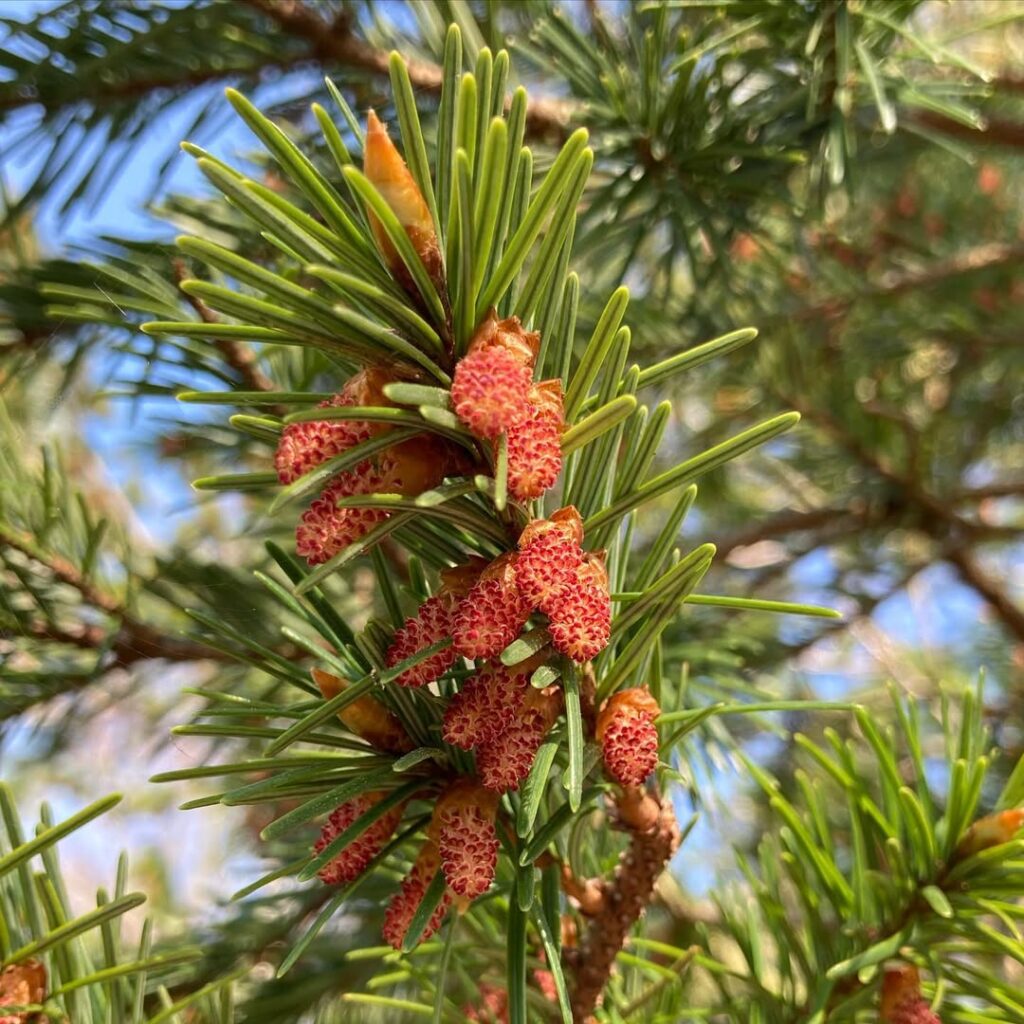
Douglas Fir (Pseudotsuga menziesii) is Idaho’s most prevalent forest tree, with the Rocky Mountain variety (var. glauca) being native to the state’s mountainous regions. This evergreen conifer can reach up to 130 feet tall and live over 1,000 years, featuring flattened blue-green to dark green needles and distinctive pendulous cones. It thrives across diverse elevations from bunchgrass communities to subalpine forests, serving as essential winter habitat for elk, deer, and moose while providing year-round wildlife food sources. Despite not being a true fir, this species is distinguished by its compact, conical crown with sloping side branches and shaggy seed cones measuring 3 to 4 inches long.
- Hardiness: USDA Zone 4, tolerates cold and dry conditions
- Light: Full sun to partial shade, adaptable to various aspects
- Water: Moist to extremely dry sites, drought tolerant once established
- Soil: Wide range of soil types, various slopes and elevations
- Fertilizer: Not required, adapted to natural forest conditions
- Pest/Disease Resistance: Generally hardy with good natural resistance
- Growth Rate: Slow to moderate, slower than coastal varieties
Quaking Aspen (Populus Tremuloides)
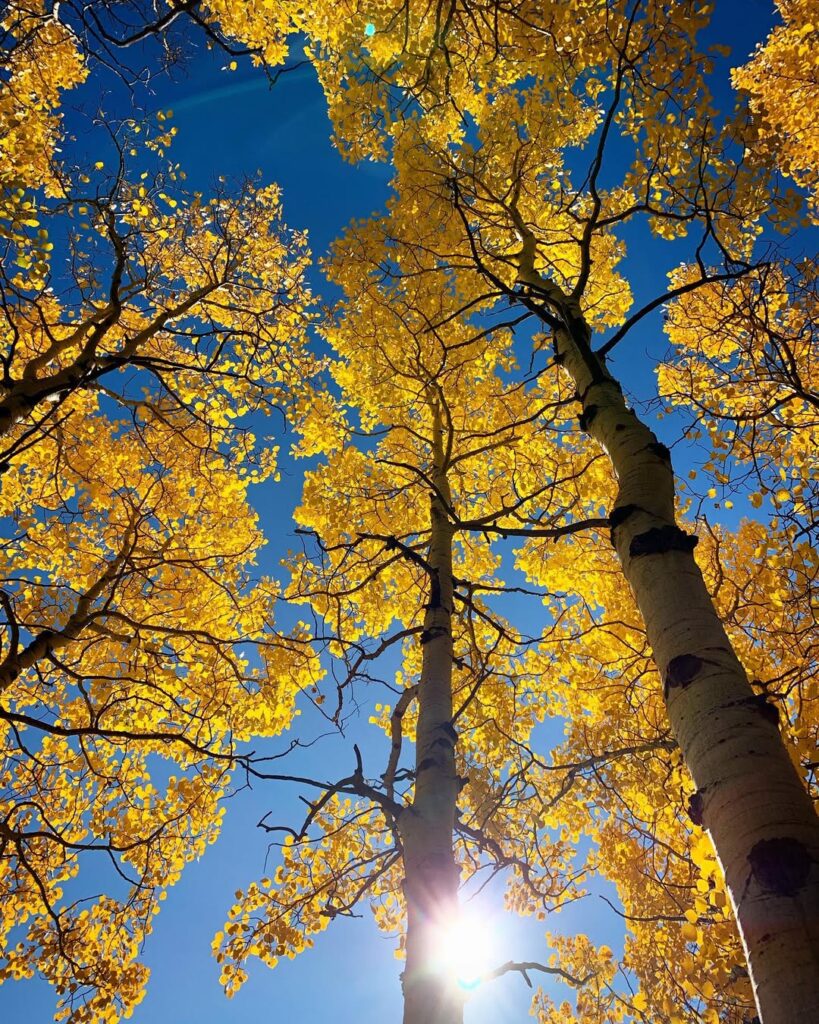
The Quaking Aspen is North America’s most widely distributed tree, known for its distinctive trembling leaves caused by flattened petioles that quake in even slight breezes. This deciduous tree features stunning white bark and vibrant golden-yellow fall coloration, making it a popular choice for landscape design.
As a pioneer species, Quaking Aspen excels at quickly colonizing open areas through its extensive root sucker system, forming large clonal colonies of genetically identical trees. It provides significant ecological value by offering wildlife habitat, controlling erosion with its extensive root system, and contributing to biodiversity in forest ecosystems. Individual trees can reach impressive heights of up to 90 feet.
- Hardiness: Thrives in cooler regions of North America; regularly occurring in Idaho
- Light: Full sun to partial shade
- Water: Prefers moist, well-drained conditions
- Soil: Slightly acidic to neutral soils; best growth on soils derived from basalt, neutral or calcareous shales, and limestones; poorest growth on granite-derived soils
- Fertilizer: Not specified in available information
- Pest/Disease Resistance: Not specified in available information
- Growth Rate: Quick establishment and fast colonization of open areas
Rocky Mountain Juniper (Juniperus Scopulorum)
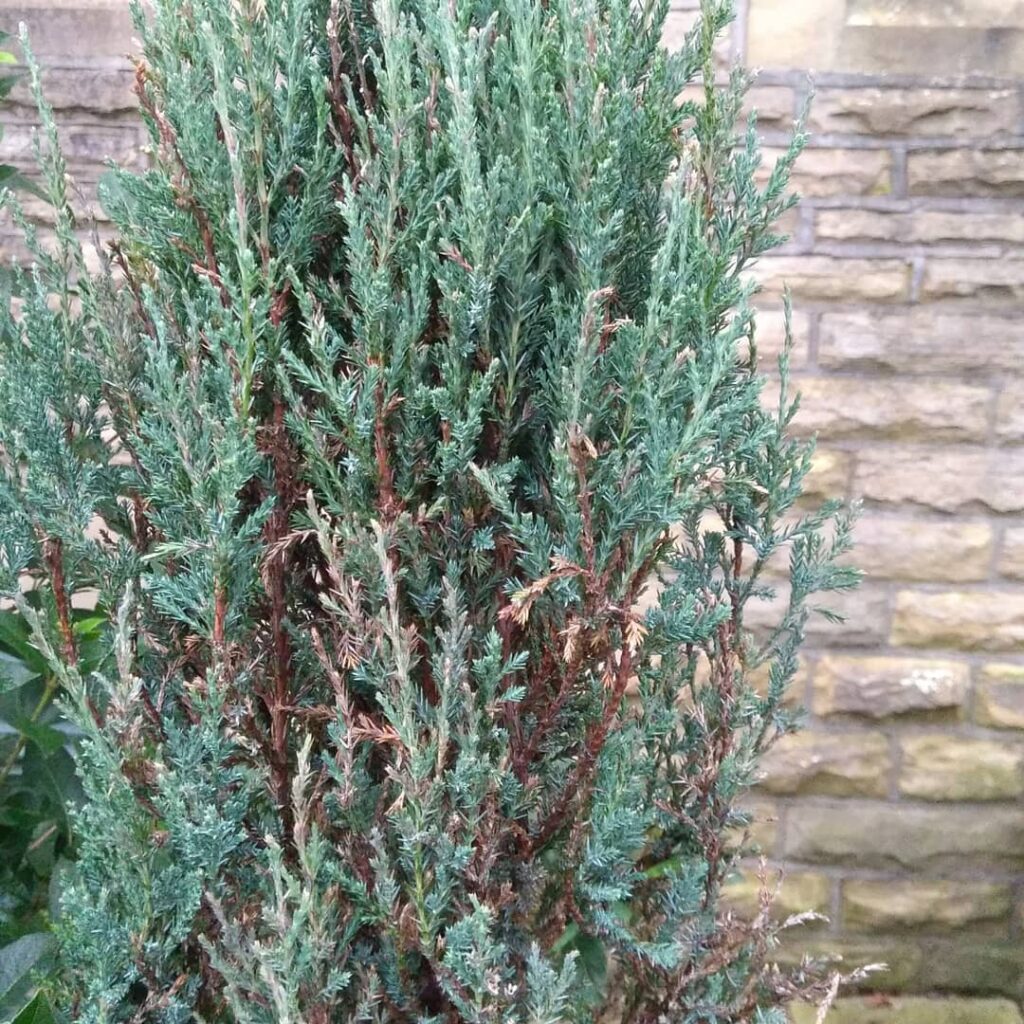
Rocky Mountain Juniper is one of the most widely distributed conifers in western North America, ranging from a small shrub to a tree reaching up to 78 inches in diameter. This dioecious species features a characteristic rounded form and produces distinctive dark blue, berry-like female cones that take two years to mature. The species is distinguished by its non-overlapping leaves and longer elliptic glands.
Exceptionally hardy and drought-tolerant, Rocky Mountain Juniper thrives in challenging conditions from prairie hillsides to montane zones. It associates with various forest types including Engelmann Spruce-Subalpine Fir and Pinyon-Juniper communities. Indigenous tribes have traditionally used this species for ceremonial incense, and it provides excellent value in designed landscapes due to its resilience and seasonal interest from September through October. In landscaped settings, this versatile conifer typically reaches heights of 10-20 feet with a spread of 8-10 feet, displaying an attractive pyramidal shape.
- Hardiness: Second only to Eastern redcedar in cold tolerance; thrives in foothills through montane zones
- Light: Full sun; tolerates exposed sites
- Water: Extremely drought tolerant once established; minimal water requirements
- Soil: Adaptable to various soil types; grows on severe sites and prairie hillsides
- Fertilizer: Low nutrient requirements; no supplemental fertilization typically needed
- Pest/Disease Resistance: Generally resistant; hardy nature provides natural disease tolerance
- Growth Rate: Slow to moderate growth rate typical of junipers
Western White Pine (Pinus Monticola)
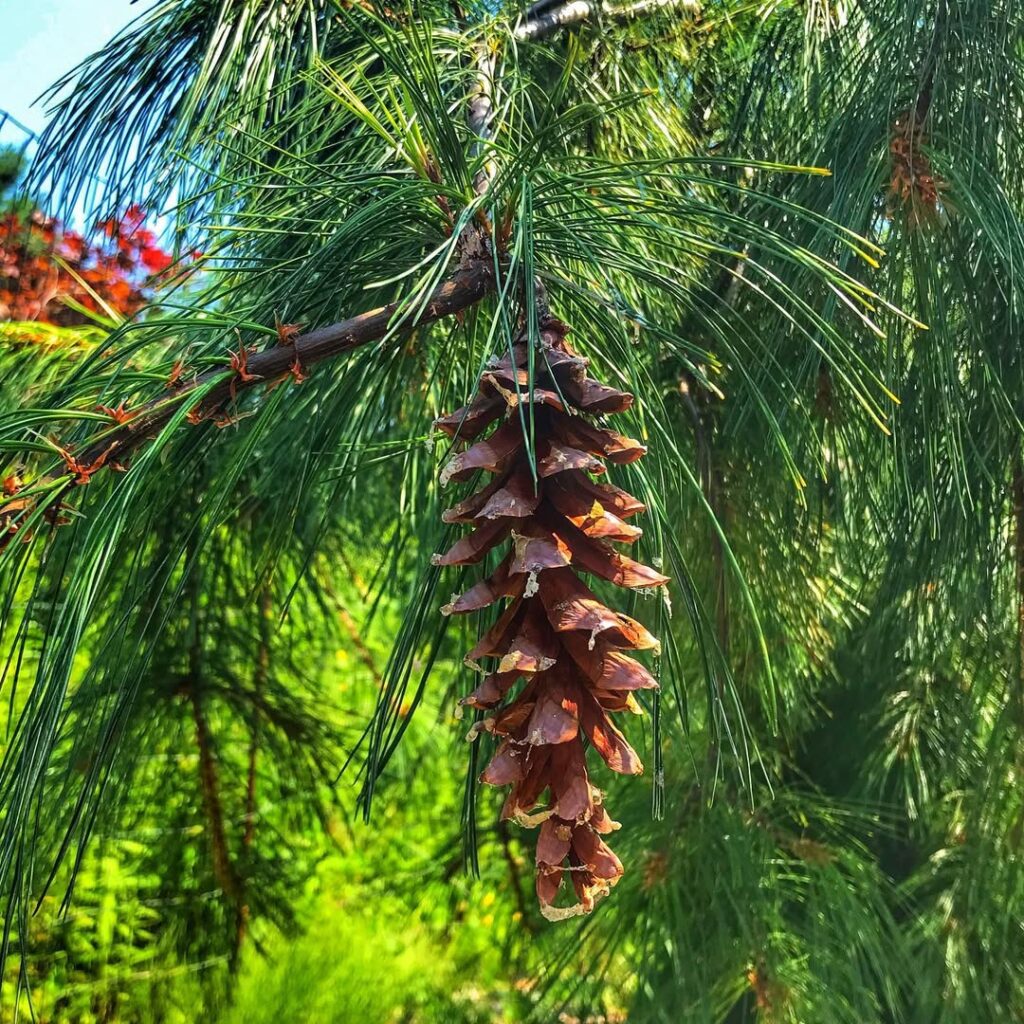
Western White Pine (Pinus monticola) is Idaho’s official state tree and one of the largest conifers native to northwestern North America. This majestic five-needled white pine can reach heights of 30-50 meters and is distinguished by its lightweight, straight-grained wood that ranges from white to pale yellow in color. The species name “monticola” means “mountain dweller,” reflecting its natural habitat in mountain ranges from British Columbia to northeastern Oregon.
Historically valued as an important timber species, Western White Pine was particularly prized for construction materials like sash, frames, and interior paneling due to its excellent dimensional stability. While commercial importance declined following the introduction of white pine blister rust disease, this native conifer remains an iconic symbol of Idaho’s forestry heritage and continues to thrive in mountainous environments throughout the Inland Empire region. The tree produces distinctive long and slender cones that measure 12–32 cm in length, making them notably larger than those of their Eastern white pine relatives.
- Hardiness: Zones 4-7, cold-hardy mountain species
- Light: Full sun to partial shade
- Water: Moderate moisture requirements, drought tolerant once established
- Soil: Well-draining, slightly acidic to neutral soils, adapts to various soil types
- Fertilizer: Low fertilizer needs, benefits from organic matter
- Pest/Disease Resistance: Susceptible to white pine blister rust; generally resistant to other pests
- Growth Rate: Moderate to slow growth rate
Gambel Oak (Quercus Gambelii)
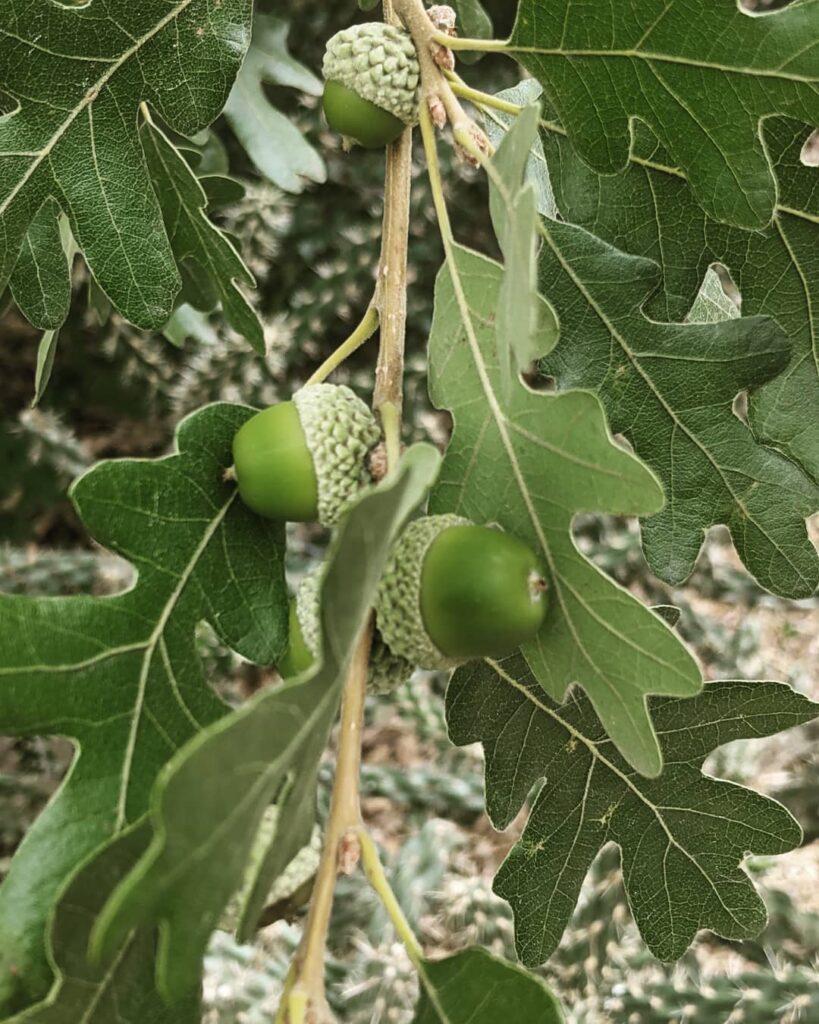
Gambel Oak is a versatile native deciduous tree or shrub naturally found throughout Idaho’s mountainous regions. This small, round-crowned tree typically reaches 30 feet in height and features deeply-lobed leaves that turn brown to red in fall. It produces acorns that provide valuable wildlife food for turkeys, squirrels, and deer. The species is highly adaptable to various soil conditions and forms dense groves, making it excellent for natural screening in landscape settings.
Originally named for naturalist William Gambel, this oak species thrives in Idaho’s climate zones and mountainous terrain. It can tolerate harsh winter conditions while preferring south-facing slopes at higher elevations. The wood serves practical purposes for fenceposts and fuel, while its ecological value includes browse for wildlife and erosion control on challenging sites like ledges and talus slopes. The species produces unisexual flowers in catkins, with both male and female flowers appearing on the same tree.
- Hardiness: USDA zones 2-8, tolerates temperatures below -0.4°F
- Light: Full sun to partial shade, prefers south-facing slopes
- Water: Moderate, requires minimum 10 inches winter precipitation annually
- Soil: Adaptable to wide variety of soils, particularly well-draining dry locations
- Fertilizer: Low maintenance, adapted to native soil conditions
- Pest/Disease Resistance: Generally hardy with good natural resistance
- Growth Rate: Slow to moderate, forms clumps and thickets over time
Hardy Shrubs for Rocky Terrain
Rocky terrain presents unique growing challenges, but several native Idaho shrubs excel in these harsh conditions, offering drought tolerance, wildlife value, and landscape functionality across diverse elevations and soil types. These hardy shrubs provide essential food sources for local birds, pollinators, and beneficial insects that struggle to find adequate nutrition in rocky mountainous environments.
Serviceberry (Amelanchier Alnifolia)

Serviceberry (Amelanchier alnifolia) is an exceptional native shrub perfectly suited for Idaho’s challenging mountain terrain. This hardy plant naturally thrives across the Pacific Northwest and Rocky Mountain regions, forming dense thickets through suckering growth. Reaching 6-12 feet tall and equally wide, serviceberry produces clusters of fragrant white flowers in early spring followed by sweet, edible purple-black berries. Its adaptability to rocky, well-drained soils and extreme weather conditions makes it invaluable for restoration projects and sustainable landscaping in Idaho’s diverse climates. The plant’s rhizome system helps control soil erosion, making it particularly valuable for stabilizing slopes and preventing degradation in mountainous areas.
- Hardiness: USDA zones 2-6, survives cold winters and late frosts
- Light: Full sun to partial shade; best flowering and fruiting in sunny locations
- Water: Drought tolerant once established; prefers moderate moisture but adapts to dry conditions
- Soil: Well-drained rocky or sandy soils; tolerates both acidic and limestone-rich conditions
- Fertilizer: Low maintenance; typically requires no supplemental fertilization
- Pest/Disease Resistance: Good resistance; withstands browsing pressure from deer, elk, and cattle
- Growth Rate: Moderate; spreads via suckering to form thickets over time
Sagebrush (Artemisia Tridentata)
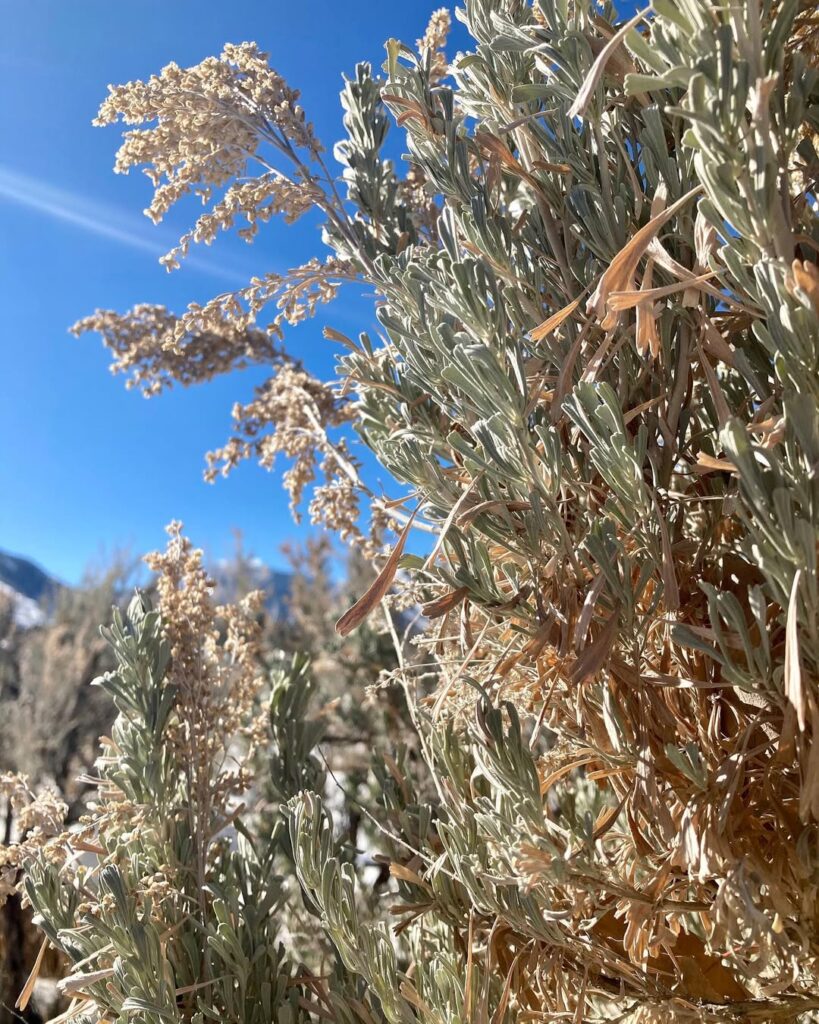
Sagebrush (Artemisia tridentata) is perhaps the most important shrub on western rangelands, serving as an evergreen cornerstone of Idaho’s native plant communities. This hardy shrub thrives in rocky terrain and varied elevations, with different subspecies adapted to specific conditions from valley bottoms to high mountain ridges. Basin big sagebrush can reach up to 13 feet tall, making it the largest subspecies, while others remain more compact.
The plant’s ecological value cannot be overstated – it provides critical habitat for sage grouse and food for mule deer, while offering year-round shelter for numerous wildlife species. Its deep root systems make it invaluable for erosion control and revegetation efforts on degraded landscapes throughout western North America. The species has no fire resistance, making it particularly vulnerable to the increased fire frequency caused by invasive grasses like cheatgrass.
- Hardiness: USDA zones 4-8, adapted to elevations from 2,600 to 10,000 feet
- Light: Full sun exposure required for ideal growth
- Water: Low to moderate; 8-16 inches annual precipitation depending on subspecies
- Soil: Well-drained, moderately deep to deep soils; adaptable to loamy, sandy, gravelly, or rocky conditions
- Fertilizer: None required; adapted to nutrient-poor native soils
- Pest/Disease Resistance: Excellent; highly resilient native species
- Growth Rate: Slow to moderate; long-lived perennial shrub
Bitterbrush (Purshia Tridentata)

Bitterbrush is a resilient deciduous shrub perfectly suited for Idaho’s challenging terrain. This multi-branched plant reaches 3-10 feet tall and features distinctive three-lobed, gray-green leaves that help conserve moisture in arid conditions. From spring through summer, it produces fragrant white to yellow flowers that attract native pollinators, particularly bees.
Beyond its ornamental value, bitterbrush serves critical ecological functions in Idaho’s landscape. Its deep root system provides excellent erosion control on slopes and disturbed sites, while its high-protein foliage offers essential winter forage for mule deer, elk, and pronghorn. The shrub also provides nesting sites and cover for various birds and small mammals, making it an invaluable component of wildlife habitat restoration projects. In eastern Washington’s sagebrush steppe, bitterbrush is commonly found as a dominant shrub in ponderosa pine forests.
- Hardiness: Extremely hardy, tolerates elevations from 200-9,000 feet in semi-arid climates
- Light: Full sun required; shade intolerant
- Water: Low water requirements; excellent drought tolerance once established
- Soil: Well-drained, rocky or gravelly soils; high tolerance for alkaline conditions and calcium carbonate
- Fertilizer: Minimal requirements; naturally improves soil fertility through nitrogen-fixing
- Pest/Disease Resistance: Generally resistant with few significant pest or disease issues
- Growth Rate: Moderate; early colonizer that establishes well on disturbed sites
Snowberry (Symphoricarpos Albus)
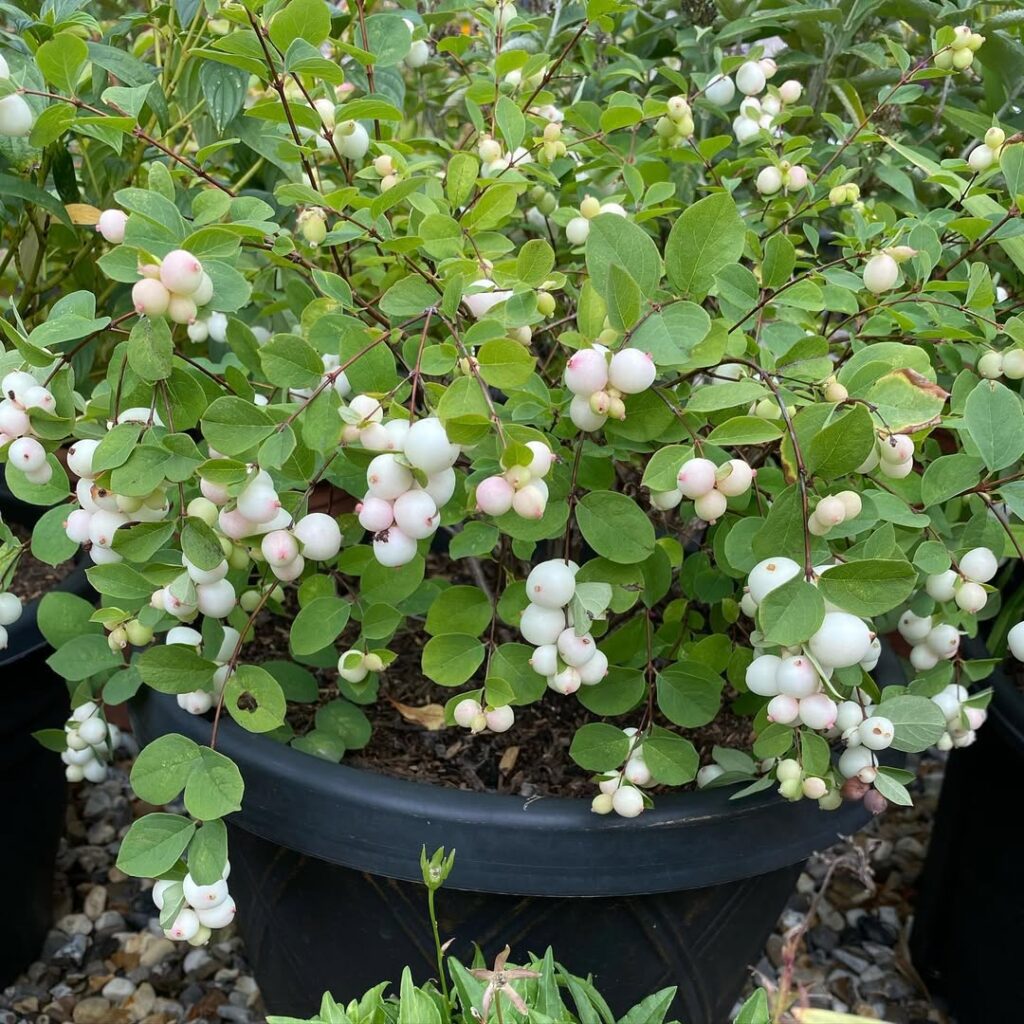
Snowberry is a resilient native shrub perfect for Idaho’s challenging rocky terrain. Growing 2-6 feet tall with a spreading habit, this deciduous plant produces clusters of small white to pinkish bell-shaped flowers from May through August. Its most distinctive feature is the waxy-white berries that persist through winter, creating striking visual interest against bare branches.
This hardy shrub thrives in Idaho’s varied elevations and soil conditions, making it invaluable for erosion control and naturalized plantings. Its extensive root system and suckering habit help stabilize slopes while providing essential wildlife habitat. The plant serves as a host for sphinx moths and attracts pollinators during blooming season, while birds rely on the persistent berries for winter sustenance. Plants can resprout from rhizomes after experiencing fire damage, making this shrub particularly valuable for post-fire restoration efforts.
- Hardiness: USDA zones 2-5
- Light: Full sun to partial shade (best flowering in full sun)
- Water: Dry to moist conditions; drought tolerant once established
- Soil: Adaptable to clay, loam, and sand; tolerates poor soils
- Fertilizer: Not required; thrives in low-nutrient conditions
- Pest/Disease Resistance: Deer resistant; generally pest-free
- Growth Rate: Moderately fast-growing
Chokecherry (Prunus Virginiana)
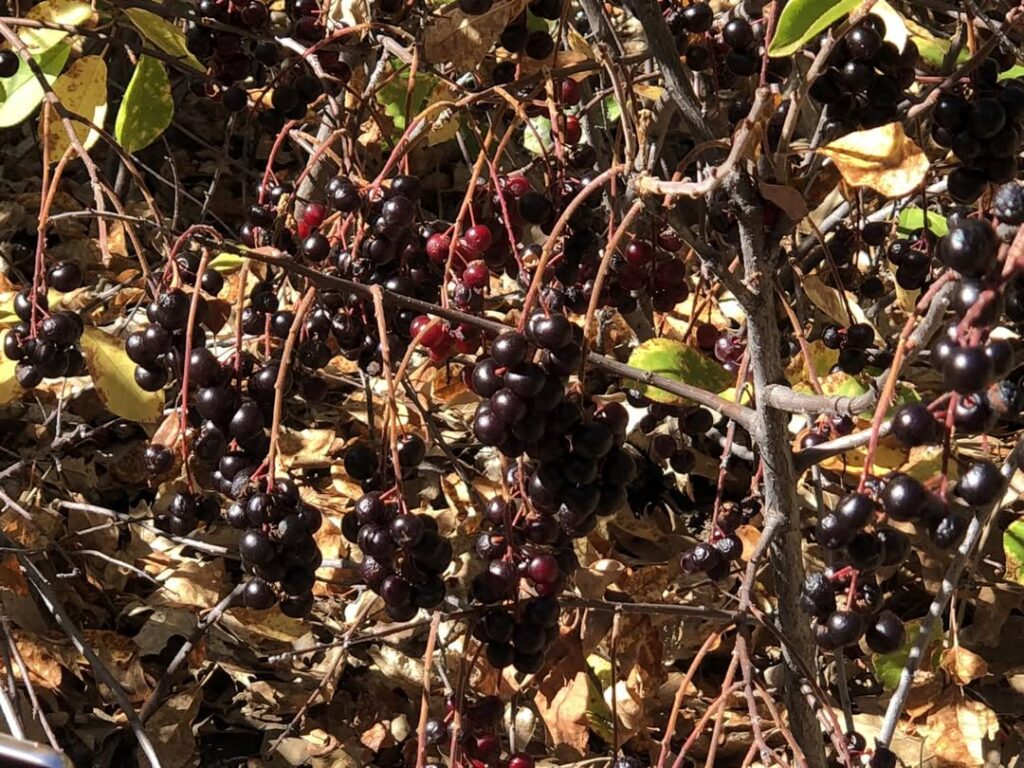
Chokecherry is a native, deciduous shrub or small tree that thrives in Idaho’s mountainous terrain. Growing 20-30 feet tall and spreading 10-20 feet wide, it produces fragrant white flower clusters in late spring followed by dark purple-black fruit in late summer. This hardy plant forms dense thickets through rhizomes, making it excellent for erosion control on slopes and rocky ground. Its ability to resprout vigorously after fire or disturbance, combined with tolerance for challenging growing conditions, makes it ideal for reclamation projects and wildlife habitat restoration.
The plant provides significant ecological benefits, supporting pollinators with its almond-scented blossoms and offering food and cover for birds, bears, and other wildlife. Its dense root system helps stabilize streambanks and prevent erosion, while the tart fruit can be processed into jams and jellies for human consumption. The antioxidant-rich berries have been traditionally valued by Native Americans who incorporated dried fruit into pemmican for long-term food storage.
- Hardiness: Zones 2-7, tolerates elevations from 5,000-8,000 feet
- Light: Full sun to partial shade
- Water: Drought tolerant once established, prefers damp conditions but adapts to various moisture levels
- Soil: Tolerates wide range of soil types including rocky terrain, prefers fertile, well-draining soils
- Fertilizer: Low maintenance, no regular fertilization needed
- Pest/Disease Resistance: Generally resistant, may host tent caterpillars
- Growth Rate: Moderate to fast, spreads readily through rhizomes
Selecting the Right Native Plants for Your Garden
When you’re choosing native plants for your Idaho garden, you’ll want to match each species to your specific conditions, soil type, and water availability. Consider the native plant benefits for your landscape’s success. Bluebunch wheatgrass works perfectly for drought-prone areas, developing roots up to 6.6 feet deep. For garden design in northern Idaho, Rocky Mountain Maple reaches 20 feet with attractive deciduous foliage. Native plants also require reduced water and nutrient inputs compared to non-native species.
Verify each plant’s origin and nativity before purchasing. Collect seeds locally or buy from reputable native nurseries nearby. This guarantees your plants maintain characteristics adapted to Idaho’s soils and climate conditions.
Frequently Asked Questions
How Do I Legally Harvest Native Plant Seeds From Public Lands?
You’ll need collection permits before harvesting seeds from public lands. Use only hand-powered methods unless you’ve received written authorization for motorized equipment. Check local district regulations since rules vary by area.
What Native Plants Are Deer Resistant in Idaho?
You’ll find excellent deer resistant flora including spider milkweed, yarrow, and monkshood among Idaho’s native plant alternatives. Consider hyssop, columbine, and penstemon as reliable options that naturally deter browsing while thriving locally.
How Much Do Native Idaho Plants Typically Cost Compared to Non-Natives?
You’ve probably noticed native plant pricing seems steep upfront—specialty nurseries charge $12-$18 per perennial versus $2.50 for non-natives. However, this cost comparison shifts favorably long-term through reduced maintenance expenses.
When Is the Best Time to Plant Native Species in Idaho?
You’ll find ideal planting seasons vary by species and location. Spring works best for cool-season natives, summer for heat-lovers like milkweed, and fall for natural stratification, matching seasonal growth patterns.
Do Idaho Native Plants Require Special Soil Amendments or Fertilizers?
You won’t need special soil amendments or fertilizers for Idaho natives since they’re adapted to local soil pH and nutrient requirements. Over-fertilizing can actually harm these plants and reduce their natural hardiness.
